Evacuees and the causes for German naval attacks on civilian ships during World War II
The Mission
In June 1940, following the retreat of the Allied forces from the European continent at Dunkirk, Germany’s armoured forces completed their blitzkrieg invasion of France.
The threat of a German invasion of England seemed sufficiently real for British authorities to consider comprehensive measures to prepare the population for such a possible military offensive. The goal was also in the spirit of a so-called “people’s war” in which every person would be called upon to contribute and ultimately make sacrifice for the victory.
Among these measures was the initiative to create the Children’s Overseas Reception Board (CORB) which was responsible for arranging the evacuation of British children. Some Allied countries, Canada and the United States in particular, volunteered to provide wartime homes and families to evacuees from Britain.
The initiative was highly popular and by July 1940, over 200,000 applications for child evacuees to be sent oversea under the CORB scheme had already been recorded.
On 13 September 1940, the steam ship SS City of Benares set sail from Liverpool with 407 passengers including 90 child evacuees. The ship was part of a British convoy bound for the Canadian ports of Québec city and Montréal, under the command of Master Landles Nicoll. The SS City of Benares was the flagship of the convoy and the first ship in the centre column.
On 17 September at 10:00 pm, German submarine U-48, under the command of Heinrich Bleichrodt, fired its torpedos at SS City of Benares which struck the flagship just below the cabins where the children were asleep in their bunks. Two children were killed instantly, and soon after the order was given to abandon the sinking ship.
It was a bitterly cold and windy night in the middle of the Atlantic ocean. Several lifeboats were smashed or capsized when they hit the stormy water. The rest of the convoy followed its course to Canada to avoid further damage. It was only the next day in the afternoon that the closest warship at sea, HMS Hurricane, arrived on the scene to rescue the survivors of the attack.
In total, 260 of the 407 people on board were lost. This included 122 crew members and 134 passengers. Only 13 of the 90 child evacuee passengers survived. The sinking was controversial, the Allied forces criticized the "barbaric" actions of the Germans.
What were the most important factors (or causes) that contributed to the sinking of the SS City of Benares?
Use the various historical sources provided in this lesson to investigate the causes of the sinking of the passenger ship SS City of Benares during World War II. Write a report in which you explain the causes of the sinking and determine who is responsible for this tragedy. When determining the reasons (or causes), you may want to consider the following aspects:
• The immediate reasons and the underlying factors for the sinking of the ship
• German naval warfare strategy during World War II
• British and Allied technology and level of preparedness in the early stage of the war
